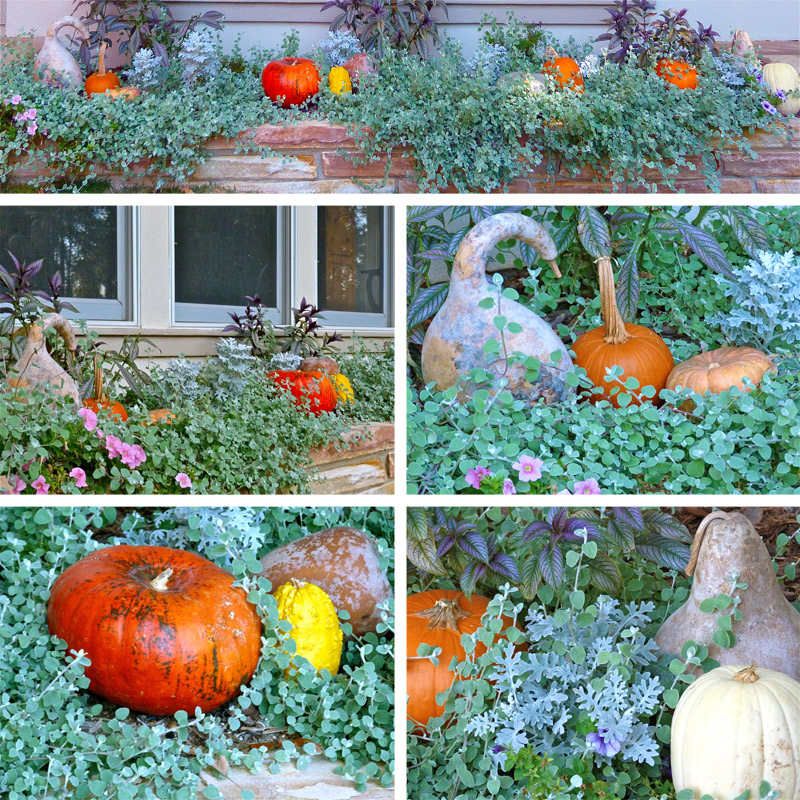Across the front of my house, under some big windows, is a long stone planter. Today it is filled with persistent plants from summer which haven't yet succumbed to cool weather: Licorice plant (Helichrysum petiolare) with its silvery velveteen leaves, soft white dusty miller, a few petunias, and Persian shield (strobilanthes dyerianus). To give it a fall update, I placed gourds and pumpkins amongst the other plants. The Persian Shield and petunias are looking bad, and I probably should pull them. The other plants don't know they are annuals and continue to flourish.
The planter has always been difficult. When I moved here, I dreamed of romantic flowers spilling over the rock facing. I wondered why the previous owners hadn't done anything with it. I soon discovered the planter received full, hot afternoon sun and absolutely no rain, for the roof overhung the area. The rocks held in the heat of the sun and created the microclimate of an oven.
The biggest problem the planter had, however, was our English setter Susie, an intelligent animal with a championship bloodline. The day after I planted flowers in the front planter I found them all dug up and withering in the sun. Susie was lying in the planter, resting in a freshly dug hole. She looked at me in defiance, and I knew I had a problem. Susie was a sweet dog, but she was the most stubborn, hard-headed, determined creature on earth. She owned the outside world. She liked to sit in front of the house and oversee us humans as we planted, watered, and mowed her kingdom. The planter was her favorite spot for a nap or to watch the goings-on in the front yard, and she claimed it for her own.
So began the War of the Planter. I would chase Susie out of the planter, and she would slink off into the woods with her tail between her legs, a sad, penitent expression on her face. It was an act. The minute I turned away, she was back in the planter, digging a new hole.
Months dragged by, and I was tired of the deep ugly holes, right by my front door. I still dreamed of flowers. My husband and I finally, in desperation, hatched a plot to break Susie of digging holes there. We had some sharp carpet tacks left over from a remodeling job. We decided to put them in the planter. Although I had threatened to kill Susie and had often described how awful her demise would be if ever I caught her in the planter again, she knew they were empty threats. But I figured the first time she stepped on one of the tacks, her bad habit would be broken and I would have the planter for my own.
So one evening we scattered the tacks in the planter and covered them with a light layer of mulch. Afterwards I listened for a yelp. We never hear a sound. The next morning I looked out, and there was Susie, cuddled up in a newly dug doggie hole, snug as a baby in a bassinet. We found the carpet tacks all together in a neat little pile to the side.
Eventually I planted spreading juniper in the planter. These durable plants are often used by landscapers to control soil erosion on steep slopes; even Susie couldn't kill a spreading juniper. The horizontal branches hid the holes Susie dug, and she would lie comfortably, peeking out from amidst the greenery. We declared a truce, and the War of the Planter came to an end.
Susie lived a long, happy life. Today she is buried under a dogwood tree in the woodland garden. The juniper is also long gone, but I still think of Susie when I look at the planter.
She was a good dog, and we loved her.
 Tuesday, November 15, 2011 at 5:00AM
Tuesday, November 15, 2011 at 5:00AM 
 Permalink
Permalink  Japanese maples,
Japanese maples,  fall foliage in
fall foliage in  fall,
fall,  trees
trees